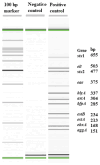In-Feed vs. In-Water Chlortetracycline Administration on the Fecal Prevalence of Virulence Genes and Pathotypes of Escherichia coli Involved in Enteric Colibacillosis in Piglets
- PMID: 40572073
- PMCID: PMC12194957
- DOI: 10.3390/microorganisms13061185
In-Feed vs. In-Water Chlortetracycline Administration on the Fecal Prevalence of Virulence Genes and Pathotypes of Escherichia coli Involved in Enteric Colibacillosis in Piglets
Abstract
Colibacillosis in nursery pigs, caused by Escherichia coli (ETEC, EPEC, and STEC pathotypes), remains a major economic concern in the swine industry. This study evaluated the effects of in-feed or in-water chlortetracycline (CTC) administration on the fecal prevalence of virulence genes and pathotypes associated with colibacillosis. A total of 1296 weaned piglets (21 days old) were allocated to 48 pens (16 pens/treatment; 27 piglets/pen) and assigned randomly to no CTC, in-feed CTC, or in-water CTC groups. CTC was administered from days 0 to 14. Fecal samples from five piglets per pen on days 0, 14, and 28 were enriched, screened by 11-plex PCR, cultured for pathotypes, and tested for CTC susceptibility and tetracycline resistance genes. None of the 360 fecal samples or 3267 E. coli isolates were positive for bfpA or aggA. Prevalence of estB (96.9%) and astA (92.8%) was highest. ETEC was the dominant pathotype (41.2%), with astA (29%) and estB (21.9%) as predominant enterotoxin genes. CTC administration had no significant effect on fecal prevalence of virulence genes or pathotypes (p > 0.05). stx2 and STEC were detected only at day 28, all harboring stx2e. All pathotypes were CTC-resistant, with tetA as the predominant resistance gene.
Keywords: Escherichia coli; PCR; chlortetracycline; colibacillosis; pathotypes; piglets; virulence genes.
Conflict of interest statement
The authors declare no conflicts of interest.
Figures





Similar articles
-
Molecular characterization of enteropathogenic Escherichia coli isolated from patients with gastroenteritis in a tertiary referral hospital of northeast India.Indian J Med Microbiol. 2024 Jan-Feb;47:100535. doi: 10.1016/j.ijmmb.2024.100535. Epub 2024 Feb 15. Indian J Med Microbiol. 2024. PMID: 38350526
-
Description of a contemporary pathogenic Escherichia coli isolated from pigs with post-weaning diarrhea in the United States from 2010 to 2023.Vet Res. 2025 Jul 1;56(1):130. doi: 10.1186/s13567-025-01568-y. Vet Res. 2025. PMID: 40597240 Free PMC article.
-
Genomic features of three major diarrhoeagenic Escherichia coli pathotypes in India.Microb Genom. 2025 Jul;11(7):001430. doi: 10.1099/mgen.0.001430. Microb Genom. 2025. PMID: 40622118 Free PMC article.
-
Intravenous magnesium sulphate and sotalol for prevention of atrial fibrillation after coronary artery bypass surgery: a systematic review and economic evaluation.Health Technol Assess. 2008 Jun;12(28):iii-iv, ix-95. doi: 10.3310/hta12280. Health Technol Assess. 2008. PMID: 18547499
-
Adefovir dipivoxil and pegylated interferon alfa-2a for the treatment of chronic hepatitis B: a systematic review and economic evaluation.Health Technol Assess. 2006 Aug;10(28):iii-iv, xi-xiv, 1-183. doi: 10.3310/hta10280. Health Technol Assess. 2006. PMID: 16904047
References
-
- Moxley R.A., Duhamel G.E. Comparative pathology of bacterial enteric diseases of swine. Adv. Exp. Med. Biol. 1999;473:83–101. - PubMed
-
- Garcia-Menino I., Garcia V., Mora A., Diaz-Jimenez D., Flament-Simon S.C., Alonso M.P., Blanco J.E., Blanco M., Blanco J. Swine enteric colibacillosis in Spain: Pathogenic potential of mcr-1 ST10 and ST131 E. coli isolates. Front. Microbiol. 2018;9:2659. doi: 10.3389/fmicb.2018.02659. - DOI - PMC - PubMed
Grants and funding
LinkOut - more resources
Full Text Sources

